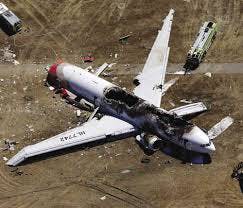Nov. 21--An automated system designed to alert key managers at San Francisco International Airport to an emergency failed within minutes of the airport's biggest disaster ever, the crash of an Asiana Airlines jetliner in July, according to an analysis that officials released Wednesday.
Rather than work as designed and send computer-generated voice mails to managers needed to coordinate the response to the Boeing 777 crash July 6, the system worked so slowly because of a software glitch that those on duty had to call more than 100 key officials one by one, said Charles Schuler, head of external communications at the airport. The airport had paid $11,750 a year for the system.
It is not clear what effect the failure had on the overall response to the crash of Asiana Flight 214, in which three passengers were killed and about 180 were injured, officials said. But, they noted, it was one of several areas where the review found room for improvement in SFO's response to crashes and other emergencies.
The review, done by the aviation consulting firm ICF SH&E, also found that the airport's website went down shortly after the crash, unable to handle the crush of users trying to learn details about the disaster and whether other flights at SFO had been redirected or canceled.
The website -- run out of a single network server in Denver -- normally handled about 19,000 visitors a day and cost $180,000 to set up. It began failing within two minutes of the 11:28 a.m. crash and went dark completely in 30 minutes, hit by a wave of as many as 75,000 users, Schuler said.
The lack of SFO-provided facts led to widespread misinformation, including early reports that the downed plane was a cargo jet.
Falling back on Twitter
It took hours for SFO technicians to put up a page that referred people to Twitter, which became the airport's fallback method of updating the public about its operations and status of repairs of its runways. "With the website down, that became our primary channel of communications," Schuler said.
Many people were already flocking to the social media service, as survivors and bystanders started tweeting messages and images within minutes of the crash.
The airport's 8-year-old website was "ancient" by current standards, Schuler said. On Aug. 20, the airport replaced it with a system that works off an Amazon cloud-based platform.
"The plan was to move the website to a system that did provide redundancy," Schuler said, "so our response would be better than what happened on July 6."
Questions unanswered
John Martin, director of the airport, said some of the consultants' findings won't be released until after the National Transportation Safety Board completes its investigation of the crash, most likely next year.
One area not covered in Wednesday's briefing was the apparent communications breakdown between San Francisco Fire Department units stationed at the airport and their city-based supervisors that led to a fire rig running over a crash survivor.
Footage recorded by a fire lieutenant's helmet camera, reviewed by The Chronicle, shows that firefighters spraying flame-retardant foam on the burning plane did not alert commanders to the presence of the victim, 16-year-old Ye Meng Yuan, whom they had already found on the ground near the plane's left wing. She eventually became covered in foam and was struck and killed by a fire rig.
Officials also did not divulge any findings the review may have reached on possible communications problems between the airport's control tower and emergency responders. Two pilots of a United Airlines jet told air traffic controllers five minutes after the crash that they could see survivors who had been ejected from the plane and who clearly needed help, according to an audio recording.
San Francisco fire officials have said they did not learn about that group of critically injured victims until 14 minutes after the crash -- and only after an airport field officer made a report to them.
It is unclear whether air traffic controllers relayed the information to rescuers or whether they heard the exchange during the chaotic first moments after the crash.
New hotline
One lesson the airport learned from the crash, Martin and other officials said, was the immediate need to have a hotline linking controllers in the tower to the emergency command center managers on the ground. Such a line has since been installed.
Despite the problems in some areas, Martin said, much of the airport's response went well. By the time he arrived about 40 minutes after the crash, 60 airport staffers, together with police, firefighters and other first responders, were "working seamlessly together," Martin said.
One success, said Schuler, came when the airport received complaints of local hotels "gouging" crash survivors who needed places to stay while they waited for the airport to resume operations. SFO and travel association officials got hoteliers to back off, he said.
"We were getting reports that some hotels were charging $400 to $500 a night," Schuler said. "I'm all for business, but that wasn't right."
Jaxon Van Derbeken is a San Francisco Chronicle staff writer. E-mail: [email protected]
Copyright 2013 - San Francisco Chronicle





